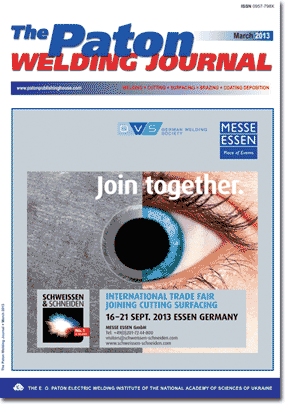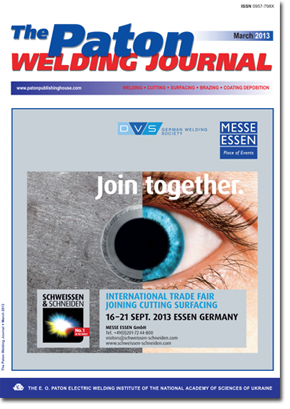| 2013 №03 (07) | 2013 №03 (09) |

The Paton Welding Journal, 2013, #3, 38-45 pages
APPLICATION OF MECHANIZED WELDING WITH SELF-SHIELDING FLUX-CORED WIRE IN REPAIR OF METALLURGICAL EQUIPMENT
V.N. SHLEPAKOV1, Yu.A. GAVRILYUK1, A.S. KOTELCHUK1, V.N. IGNATYUK1, P.A. KOSENKO2, O.N. ROKHLIN3 and A.V. TOPCHY3
1E.O. Paton Electric Welding Institute, NASU, Kiev, Ukraine
2SE «Pilot Plant of Welding Consumables of the E.O. Paton Electric Welding Institute», Kiev, Ukraine
3PJSC «Dneprovsky F.E. Dzerzhinsky Metallurgical Works», Dneprodzerzhinsk, Ukraine
Abstract
The state-of-the-art and characteristics of objects of repair-and-restoration welding of equipment of mine-metallurgical equipment were considered. It was established that reduction of time of welding during repair of metallurgical equipment and increase of reliability of welded structures are possible due to widening of application of mechanized welding using self-shielding flux-cored wire. The investigation of physical and chemical properties of powder mixtures, modeling the cores of self-shielding flux-cored wires, allow determining the ways of increasing the technological characteristics of those wires during development of their compositions. The results of works on improvement of technology of production of flux-cored wires, allowing application the efficient routes of drawing, suitable for manufacture of flux-cored wires of small diameter (1.6 mm) per one stage of drawing using six-fold drawing mill. The successful realization of technology of wire drawing with deposition of protective coating on its surface for protection against corrosion and prevention of wetting of core materials. The successful examples of implementation of mechanized welding using flux-cored wire on the typical objects pf repair-restoration works of enterprises of mine-metallurgical complex were shown. The evaluation of technical and economical characteristics of application of welding using flux-cored wires during repair-restoration works was made by calculation of expected economic effect from the replacement of manual arc welding by the mechanized one on the example of capital repair of converter. The decrease of cost of steel being melted is achieved by decrease of conditionally-constant costs at the general decrease of terms of the converter repair. 11 Ref., 7 Figures.
Keywords: repair-restoration welding, flux-cored wire, service life, equipment, mine-metallurgical complex
Received: 25.01.13
Published: 28.03.13
References
1. Shlepakov, V.M., Gavrylyuk, Yu.O., Kotelchuk, O.S. et al. (2009) Technology of renovation of units and load lifting mechanisms in design position using flux-cored wire welding. In: Problems of resource and service safety of structures, constructions and machines. Kyiv: PWI, 634-640.
2. Ilyushenko, V.M., Voropaj, M.M., Polyakov, V.O. (2006) Technological specifics of automatic arc welding processes in repair of large-size tanks. Ibid., 527-531.
3. Bolshakov, V.N. (2005) Problems of improvement of strength and reliability of furnace mantles in works of IFM. In: Fundamental and Applied Issues of Ferrous Metallurgy, Issue 11, 237-246.
4. Shlepakov, V.N., Kotelchuk, A.A. (2012) Investigation of thermochemical characteristics of mixtures of dispersed materials by differential thermal analysis methods. The Paton Welding J., 12, 13-16.
5. Shlepakov, V.N., Suprun, S.A., Kotelchuk, A.S. (1990) Estimating of the characteristics of flux-cored wire welding under the wind flow effect. In: Proc. of Int. Conf. on Welding under Extreme Conditions (Helsinki, Finland, Sept. 4-5, 1989). Oxford; New York: Pergamon Press, 171-179.
6. Pokhodnya, I.K., Alter, V.F., Shlepakov, V.N. et al. (1980) Manufacturing of flux-cored wire. Kiev: Vyshcha Shkola.
7. DSTU (GOST) 26271-84: Flux-cored wires for arc welding of carbon and low alloy steels. Moscow: Standart.
8. ISO 17632:2004(E): Welding consumables Е Tubular cored electrodes for gas shielded and non-gas shielded metal arc welding of non-alloy and fine grain steels Е Classification. Switzerland ISO copyright office.
9. Cherednichenko, G.I., Frojshteter, G.B., Stupak, P.M. (1986) Physico-chemical and thermophysical properties of lubricants. Leningrad: Khimiya.
10. Ishchuk, Yu.L. (1986) Technology of plastic lubricants. Kiev: Naukova Dumka.
11. (2001) Lubricants for the metal forming industry: Richards Apex. USA P.A.
Suggested Citation
V.N. SHLEPAKOV1, Yu.A. GAVRILYUK1, A.S. KOTELCHUK1, V.N. IGNATYUK1, P.A. KOSENKO2, O.N. ROKHLIN3 and A.V. TOPCHY3 (2013) APPLICATION OF MECHANIZED WELDING WITH SELF-SHIELDING FLUX-CORED WIRE IN REPAIR OF METALLURGICAL EQUIPMENT. The Paton Welding J., 03, 38-45.The cost of subscription/purchase order journals or individual articles
| Journal/Currency | Annual Set | 1 issue printed |
1 issue |
one article |
| TPWJ/USD | 384 $ | 32 $ | 26 $ | 13 $ |
| TPWJ/EUR | 348 € | 29 € | 24 € | 12 € |
| TPWJ/UAH | 7200 UAH | 600 UAH | 600 UAH | 280 UAH |
| AS/UAH | 1800 UAH | 300 UAH | 300 UAH | 150 UAH |
| AS/USD | 192 $ | 32 $ | 26 $ | 13 $ |
| AS/EUR | 180 € | 30 € | 25 € | 12 € |
| SEM/UAH | 1200 UAH | 300 UAH | 300 UAH | 150 UAH |
| SEM/USD | 128 $ | 32 $ | 26 $ | 13 $ |
| SEM/EUR | 120 € | 30 € | 25 € | 12 € |
| TDNK/UAH | 1200 UAH | 300 UAH | 300 UAH | 150 UAH |
| TDNK/USD | 128 $ | 32 $ | 26 $ | 13 $ |
| TDNK/EUR | 120 € | 30 € | 25 € | 15 € |
AS = «Automatic Welding» - 6 issues per year;
TPWJ = «PATON WELDING JOURNAL» - 12 issues per year;
SEM = «Electrometallurgy Today» - 4 issues per year;
TDNK = «Technical Diagnostics and Non-Destructive Testing» - 4 issues per year.


